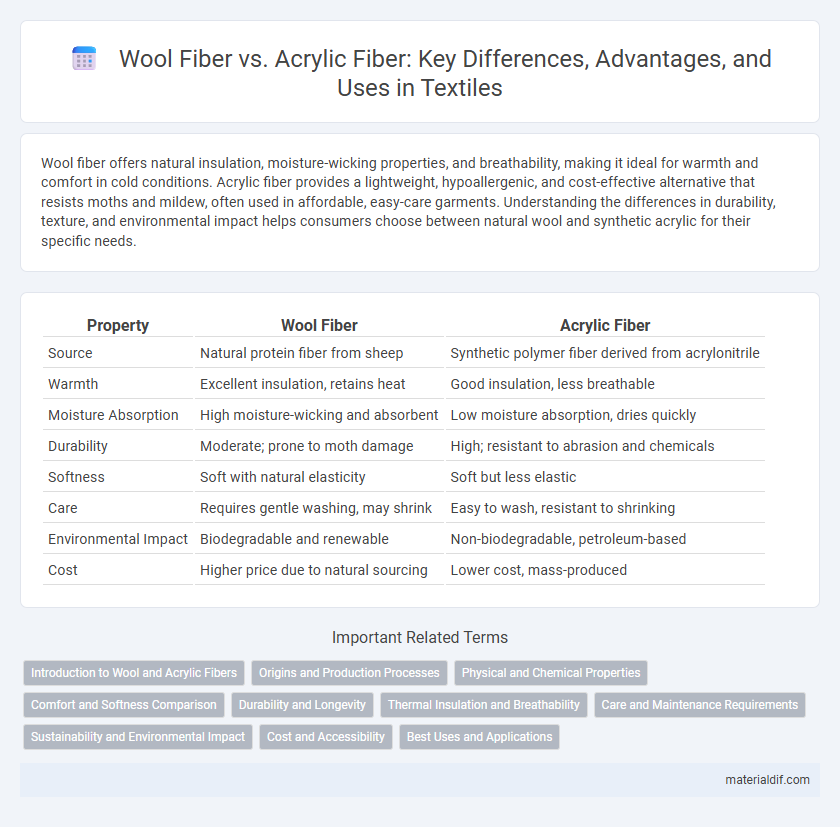Wool fiber offers natural insulation, moisture-wicking properties, and breathability, making it ideal for warmth and comfort in cold conditions. Acrylic fiber provides a lightweight, hypoallergenic, and cost-effective alternative that resists moths and mildew, often used in affordable, easy-care garments. Understanding the differences in durability, texture, and environmental impact helps consumers choose between natural wool and synthetic acrylic for their specific needs.
Table of Comparison
| Property | Wool Fiber | Acrylic Fiber |
|---|---|---|
| Source | Natural protein fiber from sheep | Synthetic polymer fiber derived from acrylonitrile |
| Warmth | Excellent insulation, retains heat | Good insulation, less breathable |
| Moisture Absorption | High moisture-wicking and absorbent | Low moisture absorption, dries quickly |
| Durability | Moderate; prone to moth damage | High; resistant to abrasion and chemicals |
| Softness | Soft with natural elasticity | Soft but less elastic |
| Care | Requires gentle washing, may shrink | Easy to wash, resistant to shrinking |
| Environmental Impact | Biodegradable and renewable | Non-biodegradable, petroleum-based |
| Cost | Higher price due to natural sourcing | Lower cost, mass-produced |
Introduction to Wool and Acrylic Fibers
Wool fiber, derived from the fleece of sheep, is a natural protein fiber known for its excellent insulation, moisture-wicking capabilities, and biodegradability. Acrylic fiber, a synthetic polymer made from polyacrylonitrile, offers lightweight, soft, and durable characteristics with resistance to moths and chemicals. Both fibers serve diverse applications in textiles, with wool valued for warmth and breathability and acrylic favored for affordability and ease of care.
Origins and Production Processes
Wool fiber originates from the fleece of sheep and involves shearing, cleaning, carding, and spinning to transform natural protein fibers into yarn. Acrylic fiber is a synthetic material produced through polymerization of acrylonitrile monomers, followed by extrusion and spinning into fine filaments. The production of wool is labor-intensive and relies on animal sources, while acrylic fiber manufacturing is a chemical and industrial process enabling mass production.
Physical and Chemical Properties
Wool fiber, a natural protein fiber from sheep, exhibits high elasticity, moisture-wicking capabilities, and excellent insulation due to its crimped structure and keratin composition. Acrylic fiber, a synthetic polymer made from polyacrylonitrile, offers superior resistance to moisture, sunlight, and chemicals but lacks the breathability and warmth retention of wool. Wool fibers are biodegradable and flame-resistant, whereas acrylic fibers are less durable under heat and more prone to static buildup.
Comfort and Softness Comparison
Wool fiber offers superior comfort and softness due to its natural crimp, moisture-wicking properties, and breathability, making it ideal for temperature regulation and reducing skin irritation. Acrylic fiber, while soft and lightweight, often feels less breathable and can retain heat, sometimes causing discomfort in prolonged wear. Wool's natural elasticity and resilience also enhance its softness over time, whereas acrylic tends to lose shape and softness with repeated use.
Durability and Longevity
Wool fiber offers superior durability and longevity due to its natural crimp and elasticity, which helps it resist wear and tear while retaining shape over time. Acrylic fiber, though lightweight and resistant to moths and mildew, tends to pill and degrade faster with prolonged use. Choosing wool ensures extended fabric lifespan and sustained performance in high-use applications.
Thermal Insulation and Breathability
Wool fiber offers superior thermal insulation due to its natural crimp, which traps heat and maintains warmth even when damp, making it ideal for cold environments. Acrylic fiber, while providing decent insulation, lacks the moisture-wicking properties present in wool, resulting in reduced breathability and potential overheating during extended wear. Wool's ability to regulate temperature through moisture management enhances comfort, whereas acrylic fibers tend to retain heat and moisture, limiting airflow and breathability.
Care and Maintenance Requirements
Wool fiber requires gentle care including hand washing with mild detergent and air drying to prevent shrinking and damage, while acrylic fiber offers easy maintenance with machine washability and quick drying properties. Wool's natural lanolin content provides some resistance to dirt and odor but demands careful handling to maintain softness and shape. Acrylic fibers are more durable in high temperatures and less prone to pilling, making them ideal for low-maintenance textile products.
Sustainability and Environmental Impact
Wool fiber is a natural, biodegradable material that supports sustainable farming practices and reduces landfill waste through its compostability. Acrylic fiber, a synthetic polymer derived from petroleum, contributes to microplastic pollution and is non-biodegradable, leading to long-term environmental harm. Wool production generally has a lower carbon footprint when managed responsibly, while acrylic manufacturing involves higher energy consumption and greenhouse gas emissions.
Cost and Accessibility
Wool fiber typically costs more due to its natural origin and labor-intensive production, making it less accessible in some markets compared to acrylic fiber. Acrylic fiber offers a cost-effective alternative with widespread availability, derived from synthetic materials that allow mass production at lower prices. Consumers seeking budget-friendly options often prefer acrylic, while wool remains valued for its quality despite the higher cost.
Best Uses and Applications
Wool fiber excels in insulation and moisture-wicking, making it ideal for cold-weather clothing, high-performance outdoor gear, and luxury textiles. Acrylic fiber offers durability, colorfastness, and easy care, which suits affordable fashion, upholstery, and machine-washable blankets. Wool is best for thermal regulation and natural comfort, while acrylic is preferred for cost-effective, lightweight, and hypoallergenic alternatives.
Wool Fiber vs Acrylic Fiber Infographic

 materialdif.com
materialdif.com